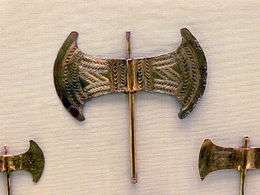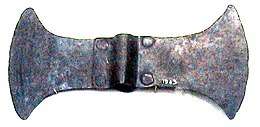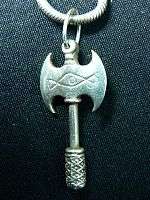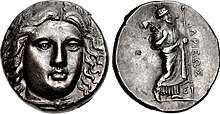Labrys
Labrys (Greek: λάβρυς, romanized: lábrus) is, according to Plutarch (Quaestiones Graecae 2.302a), the Lydian word for the double-bitted axe. (Greek: πέλεκυς, pélekus).


Etymology
Plutarch relates that the word labrys was a Lydian word for "axe": Λυδοὶ γὰρ ‘λάβρυν’ τὸν πέλεκυν ὀνομάζουσι.[lower-alpha 1][2] The word probably appears in Linear B inscriptions, and it may be Minoan.[3] Many scholars including Evans assert that the word labyrinth is derived from labrys, and thus would imply "house of the double axe".[4] A priestly corporation in Delphi was named "Labyades". The original name was probably "Labryades", servants of the double axe. In Roman times at Patrai and Messene, a goddess Laphria was worshipped, commonly identified with Artemis. Her name was said to be derived from the region around Delphi.[5][6]
However, in Crete the "double axe" is not a weapon and always accompanies women and not a male god.[7] Beekes regards the relation of labyrinth with labrys as speculative, and rather proposes a relation with laura (λαύρα), "narrow street", or to the Carian theonym Dabraundos (Δαβραυνδος).[8] It is also possible that the word labyrinth is derived from the Egyptian loperohunt, meaning "palace or temple by the lake". The Egyptian labyrinth near Lake Morris is described by Herodotus and Strabo.[9] The inscription in Linear B, on tablet ΚΝ Gg 702, reads da-pu2-ri-to-jo-po-ti-ni-ja. The conventional reading is λαβυρίνθοιο πότνια ("mistress of the labyrinth"). According to some modern scholars it could read *δαφυρίνθοιο, or something similar, and hence be without a certain link with either the λάβρυς or the labyrinth.[lower-alpha 2]
A link has also been posited with the double axe symbols at Çatalhöyük, dating to the Neolithic age.[10] In Labraunda in Caria, as well as in the coinage of the Hecatomnid rulers of Caria, the double axe accompanies the storm god Zeus Labraundos.[lower-alpha 3][11]
The Minoan double axe
In ancient Crete, the double axe was an important sacred symbol of the supposed Minoan religion.[12] In Crete it never accompanies male gods, only female goddesses. It seems that it was the symbol of the arche of the creation (Mater-arche).[13]
Double axes in the Near East
In the Near East and other parts of the region, eventually, axes of this sort are often wielded by male divinities and appear to become symbols of the thunderbolt,[14] a symbol often found associated with the axe symbol. In Labraunda of Caria the double-axe accompanies the storm-god Zeus Labraundos. Similar symbols have been found on plates of Linear pottery culture in Romania.[15] The double-axe is associated with the Hurrian god of sky and storm Teshub. His Hittite and Luwian name was Tarhun.[16] Both are depicted holding a triple thunderbolt in one hand, and a double axe in the other hand. Similarly, Zeus throws his thunderbolt to bring storm. The labrys, or pelekys, is the double axe Zeus uses to invoke storm, and the relative modern Greek word for lightning is "star-axe" (ἀστροπελέκι astropeleki)[17] The worship of it was kept up in the Greek island of Tenedos and in several cities in the south-west of Asia Minor, and it appears in later historical times in the cult of the thunder god of Asia Minor (Zeus Labrayndeus).
Ancient Greece
In the context of the mythical Attic king Theseus, the labyrinth of Greek mythology is frequently associated with the Minoan palace of Knossos. This is based on the reading of Linear B da-pu2-ri-to-jo-po-ti-ni-ja as λαβυρίνθοιο πότνια ("mistress of the labyrinth").[lower-alpha 4] It is uncertain, however, that labyrinth can be interpreted as "place of the double axes" and moreover that this should be Knossos; many more have been found, for example, at the Arkalachori Cave, where the famous Arkalochori Axe was found.
On Greek coins of the classical period (e. g. Pixodauros) a type of Zeus venerated at Labraunda in Caria that numismatists call Zeus Labrandeus (Ζεὺς Λαβρανδεύς) stands with a sceptre upright in his left hand and the double-headed axe over his shoulder.[18]
Modern uses

Religion and spirituality
It is sometimes used as a symbol of Hellenic polytheism. As a symbol of the neopagan Goddess movement, the labrys represents the memory of pre-patriarchal matristic societies.[lower-alpha 5][21]
Social movement
In feminist interpretations, the labrys is a symbol of matriarchy.[22][lower-alpha 6][23]
In Kyrgyzstan, "Labrys" is an LGBT rights organization. The group's goal is to improve the quality of life for all LGBT individuals in their country as well as Central Asia.[24]
Lesbian symbol

In the 1970s, the labrys was adopted by the lesbian community as a lesbian feminist symbol representing strength and self-sufficiency.[25][26][27][28][29] The labrys lesbian flag, created in 1999,[30] involves a labrys superimposed on the inverted black triangle and set against a violet background.
Culture
It is used by Cretan folklore preservation societies and associations both in Greece and abroad, on occasion with the spelling "lavrys" reflecting modern Greek pronunciation.
Political
In Greece, the labrys was employed as a symbol of Metaxism.[31] During the totalitarian period of the 4th of August Regime (1936–1941), it represented the regime-sponsored National Organization of Youth (EON), as its leader, Ioannis Metaxas, believed it to be the first symbol of all Hellenic civilizations.[31]
The labrys symbol was also used prominently by the Vichy France regime, being featured on the personal flag of Chief of State Philippe Pétain, on coins, and in various propaganda posters.[32]
In the 1960s the labrys was also used by the Italian neo-fascist and far-right movement Ordine Nuovo, most prominently on their flag.[33]
Weapon
While double axes are common in modern high fantasy settings, in reality they were not commonly used in combat.
Sport
Double-bit axes were common in North American forestry, one blade would be sharp and used for felling whilst the other was a little blunter for limbing. As the forest workers (lumberjacks) were often away from civilisation for long periods of time they needed a way to amuse themselves. Thus the sport of double-bit axe throwing was born. In recent decades the sport has been formalised with Swedish company Gränsfors Bruk writing the rules most widely accepted. There are now multiple clubs across Europe that throw double-bit. Important to note that the sport of Double-bit was formalised in the 1990s, whilst hatchet throwing was formalised in 2006. [34]
See also
- Arkalochori Axe
- Axe (tool)
- Battle axe
- Bronze Age sword
- Fasces
- Francisca
- Labrys religious community
- Sagaris
Notes
- "Herakles, having slain Hippolyte and taken her axe away from her with the rest of her arms, gave it to Omphale. The kings of Lydia who succeeded her carried this as one of their sacred insignia of office, and passed it down from father to son until it was passed to Candaules, who disdained it and gave it to one of his companions to carry. When Gyges rebelled and was making war upon Candaules, Arselis came with a force from Mylasa to assist Gyges; Arselis then slew Candaules and his companion and took the axe to Caria with the other spoils of war. And, having set up a statue of Zeus, Arselis put the axe in his hand and invoked the god, Labrandeus."
- See Melena's overview in the third volume of the Companion to Linear B, p. 73 (available here).
- "It seems natural to interpret names of Carian sanctuaries like Labranda in the most literal sense as the place of the sacred labrys, which was the Lydian (or Carian) name for the Greek πέλεκυς [pelekys], or double-edged axe." And, "On Carian coins, indeed of quite late date, the labrys, set up on its long pillar-like handle, with two dependent fillets, has much the appearance of a cult image."[11]
- Cf. the parallel construction of a-ta-na-po-ti-ni-ja, perhaps referring to the “Mistress of Athens”, i. e. Athena, on a different tablet (KN V 52) from Knossos.
- "Women fought, as war leaders and in the ranks; women fought in troops, as regular soldiers; and the principal symbol of the Great Goddess, appearing widely throughout the Mediterranean and Asia Minor, was the double-headed battle axe or labrys."[20]
- The forms taken by the labrys were classified by Caterina Mavriyannaki.
References
- "Ex von Aulock Collection". Classical Numismatic Group (CNG). 2007. Retrieved 31 January 2019.
- Plutarch, Greek Questions, 45, 2.302a.
- Younger John: DA-PU ().
- The Oxford Classical Dictionary (4th ed.). Oxford: Oxford University Press. 2012. p. 960. ISBN 978-0199545568.
- Sweeney, Emmet John (2009). Gods, Heroes and Tyrants: Greek Chronology in Chaos. Algora Publishing. p. 116. ISBN 9780875866826.
- Platon, Nicolas; Tournay, Béatrice de (2015-05-18). La Civilisation égéenne -: Le Bronze récent et la civilisation mycénienne. Albin Michel. p. iii. ISBN 9782226341075.
- Nilsson, Vol. 1, p. 277.
- Beekes, Robert (2009). Etymological Dictionary of Greek. Boston, Massachusetts: Brill. p. 819. ISBN 978-9004174184.
- H. G. Wunderlich. The secret of Crete. Souvenir Press, 1975, p. 54.
- Schachermeyr, Fritz (1964). Die minoische Kultur des alten Kreta. Stuttgart: Kohlhammer Verlag. p. 161.
Abb.85
OCLC: 325167 - Arthur Evans, "Mycenaean tree and pillar cult and its Mediterranean relations". Journal of Hellenic Studies XXI, p. 108 f.
- Rutter, Jeremy (2017-11-29). "Minoan Religion".
- Schachermeyr, Fritz (1964). Die minoische Kultur des alten Kreta. Stuttgart: W. Kohlhammer Verlag. p. 161. OCLC: 325167
- Dartmouth College: Minoan Religion
- Schachermeyr, Fritz (1964). Die minoische Kultur des alten Kreta. Stuttgart: W. Kohlhammer Verlag. p. 162. OCLC: 325167
- Article "Tarhun". In: Britannica.
- M. Nilsson (1967), Die Geschichte der griechischen Religion, Vol. I, C. F. Beck Verlag, Munich, pp. 276 f.
- Jewitt, Llewellynn Frederick William (1890). English Coins and Tokens. Swan Sonnenschein & Company.
- Francis, Jane E.; Kouremenos, Anna, eds. (2016). "5. The double axe (λάβρυς) in Roman Crete and beyond: the iconography of a multi-faceted symbol". Roman Crete: New Perspectives (1st ed.). Oxford, England; Havertown, Pennsylvania: Oxbow Books. pp. 43–57. ISBN 978-1-78570-095-8.
- Miles, Rosalind (1989). "The Great Goddess". The Women's History of the World. Topsfield, Massachusetts: Salem House. p. 33. ISBN 0-88162-348-2.
- Keller, Mara (1988). "Eleusinian Mysteries" (PDF). Journal of Feminist Studies in Religion. 4 (1): 42. Retrieved 2016-06-21.
- Mavriyannaki, Caterina (1983). "La double hache dans le monde hellénique à l'âge de bronze" [The Double Axe in the Hellenic World at the Bronze Age]. Revue Archéologique. Nouvelle Série, Fasc. 2 (in French) (2): 195–228. JSTOR 41737054.
- Biedermann, Hans (1992). Dictionary of Symbolism: Cultural Icons and the Meanings Behind Them [Knaurs Lexikon der Symbole]. New York, New York: Facts on File. p. 24. ISBN 0-8160-2593-2.
- "Labrys". Labrys Kyrgyzstan. 2004–2014. Retrieved 11 May 2016.
- Zimmerman, Bonnie, ed. (2000). "Symbols, Christy Stevens". Lesbian Histories and Cultures: An Encyclopedia (1st ed.). Garland Publishing. p. 748. ISBN 0-8153-1920-7.
- Myers, JoAnne (2003). The A to Z of the Lesbian Liberation Movement: Still the Rage (The A to Z Guide Series, No. 73 ) (1st ed.). Lanham, Maryland: The Scarecrow Press. p. 205. ISBN 978-0-8108-6811-3.
- "Gay Symbols Through the Ages". The Alyson Almanac: A Treasury of Information for the Gay and Lesbian Community. Boston, Massachusetts: Alyson Publications. 1989. pp. 99–100. ISBN 0-932870-19-8.
- Murphy, Timothy F., ed. (2000). Reader's Guide to Lesbian and Gay Studies (1st ed.). Chicago, Illinois: Fitzroy Dearborn Publishers. p. 44. ISBN 1-57958-142-0.
- Pea, Georgie (9 August 2013). "LABRYS Tool of Lesbian Feminism". Finding Lesbians. Retrieved 10 July 2018.
- Bendix, Trish (September 8, 2015). "Why don't lesbians have a pride flag of our own?". AfterEllen. Archived from the original on September 9, 2015. Retrieved 24 June 2020.
- Markessinis, Andreas (August 22, 2006). "The Labrys/Pelekys: The symbol of Thundergod Zeus and of the EON". Metaxas Project. Retrieved August 31, 2014.
- Karlsgodt, Elizabeth (2011). Defending National Treasures: French Art and Heritage Under Vichy. Stanford University Press. pp. 126–128. ISBN 978-0804770187.
- Giannuli, Aldo; Rosati, Elia (October 5, 2017). Storia di Ordine Nuovo: La Piú Pericolosa Organizzazione Neo-Fascista Degli Anni Settanta [History of Ordine Nuovo: The Most Dangerous Neo-Fascist Organization of the Seventies] (in Italian). Milan, Italy: Mimesis Edizioni. ISBN 978-8857538433.
- https://www.gransforsbruk.com/en/info/axe_throwing/
Further reading
- Cooper, J. C., ed. (1978). An Illustrated Encyclopaedia of Traditional Symbols (1st ed.). London: Thames & Hudson. ISBN 978-0-500-01201-7.
- Cuhulain, Kerr (2004). "Symbols (G-N)". Pagan Protection Center. The Witches' Voice Inc.
- Enszer, Julie (June 26, 2017). "My Labrys, My Self". Argot Magazine.
- "Hellenic nativistic Collective LABRYS". Hellēnismôs. 2015.
- Rapp, Linda (2003). "Symbols" (PDF). glbtq.com.
- "Λατρευτική Κοινότητα ΛΑΒΡΥΣ" (in Greek). Worship community LAVRYS.
External links
| Wikimedia Commons has media related to Labrys. |
- "Labrys" at Oxford Dictionaries, Oxford University Press
- "Labrys" at Ancient-Symbols.com
